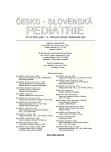Prenatal Effects of Alcohol
Authors:
J. Hamanová 1; L. Csémy 2
Authors‘ workplace:
Subkatedra dorostového lékařství IPVZ, Praha
ředitel Mgr. et Bc. R. Gabriel
1; Psychiatrické centrum, Praha
ředitel prof. MUDr. C. Höschl, DrSc.
2
Published in:
Čes-slov Pediat 2010; 65 (10): 606-612.
Category:
Postgraduate Education
Overview
Alcohol, which freely passes through the placenta as well as its metabolites exert teratogenic effects on the fetus. Alcohol consumption by pregnant women is not rare, though. In our country one third of pregnant women continued to consume alcohol during pregnancy.
A classical picture of fetal alcohol syndrome is characterized by craniofacial abnormities, growth disorder, anomalies and dysfunction of the CNS. Less significant or incomplete forms are probably less frequent. Consequently, possibilities of more precise diagnosis are searched for – several criteria systems have been developed in the U.S.A. especially for the sake of psychological and psychotherapeutic help to these patients. In the preventive point of view there is a predominant opinion that during pregnancy even a small amount of alcohol may be harmful to the fetus and pregnant women should not consume alcohol at all. The role of physician to inform the women and the society as a whole has been pointed out.
Key words:
alcohol, fetal alcohol syndrome, pregnancy, anomalies, growth and development anomalies, CNS damage, diagnostic criteria
Sources
1. Jones KL, Chamber CD, Hill LL, et al. Alcohol use in pregnancy: inadequate recommendations for and increasing problem. BJOG 2006; 113: 967–968.
2. Institute of Alcohol Studies. Binge drinking – medical and social consequencies. IAS Factsheet, September 2007.
3. Institue of Alcohol Studies. Binge drinking – nature, prevalence and causes. IAS Factsheet, June 2007.
4. Pincock S. Binge drinking on rise in UK and elsewhere. Lancet 2003; 362(4): 1126–1127.
5. Nešpor K. Světová zdravotnická organizace o alkoholu v roce 2007. Čas. Lék. čes. 2007; 146(10): 792.
6. Kubička L, Csémy L. Analýza sociodemografického kontextu požívání alkoholických nápojů v dospělé populaci České republiky z hlediska zdravotního. Čas. Lék. čes. 2004; 143(7): 435–439.
7. Nešpor K, Csémy L. Krátká intervence pro problémy působené alkoholem může probíhat v různých prostředích. Čas. Lék. čes. 2005; 144(12): 840–843.
8. Csémy L, Hamanová J. Užívání alkoholu českými adolescenty. Čes.-slov. Pediat. 2009; 64(10): 454–460.
9. Csémy L, Nešpor K. Evropský akční plán o alkoholu v České republice – žádný podstatný pokrok. Čas. Lék. čes. 2004; 143(5): 339–341.
10. Csémy L. Užívání drog mezi českými a evropskými adolescenty. Trendy a souvislosti. Čes.-slov. Pediat. 2003; 58(11): 675–680.
11. Evropské monitorovací centrum pro drogy a drogovou závislost. Zpráva ESPAD za rok 2007. Užívání návykových látek mezi studenty v 35 evropských zemích. Lucemburk: Úřad pro úřední tisky Evropských společenství, 2009.
12. Zima T. Fetální alkoholový syndrom. Protialkohol. Obzor 1994; 29(1): 7–14.
13. Heather N, Peters TJ, Stockwell T. International Handbook of Alcohol Dependence and Problems. Chichester: John Wiley & Sons Ltd., 2001.
14. Andrejková M, Šaligová J, Šoltys L. Fetálny alkoholový syndrom v pediatrickej praxi. Lek. Obzor 1996; 45(6): 183–185.
15. Kukla L, Hrubá D, Tyrlík M. Alkohol a drogy v těhotenství. Rozdíly mezi nekuřačkami a kuřačkami. Alkoholismus a drogové závislosti 1999; 34(4): 193–202.
16. Macko J. Fetální alkoholový syndrom. Neonatol. Listy 1999; 5(2): 75.
17. Seemanová E. Teratogenní fenylketonurická embryopatie. Čes.-slov. Pediat. 2007; 62(2): 108–110.
18. Wattendorf DJ, Muenke M. Fetal alcohol spectrum disorders. Amer. Fam. Phys. 2005; 72(2): 279–285.
19. Hoyme HE, Philips AM, Kalberg WO, et al. A practical clinical approach to diagnosis of fetal alcohol spectrum disorders: Clasification of the 1996 Institute of Medicine criteria. Pediatrics 2005; 115: 39–47.
20. Čech E, Hájek Z, et. al. Porodnictví. 2. vyd. Praha: Grada, 2006: 1–44.
21. Nešpor K, Csémy L. Alkohol v těhotenství. Čas. Lék. čes. 2005; 144(10): 704–705.
22. Henderson J, Gray R, Brocklehurst P. Systematic review of effects of low-moderate prenatal alcohol exposure on pregnancy outcome. BJOG 2007; 114: 243–252.
23. Green RF, Stoler JM. Alcohol dehydrogenase 1B genotype and fetal alcohol syndrome: a HuGE minireview. AJOG 2007; 12–22.
24. Stromland K, Pinazo-Duran MD. Opthalmic involvement in the fetal alcohol syndrome: clinical and animal model studies. Alcohol Alcohol. 2002; 37(1): 2–8.
25. Department of Psychiatry and Behav. Science, University of Washington School of Medicine, Fetal Alcohol and Drug Unit. Fetal Alcohol Spectrum Disorders, 2007. http://www.acbr.com/fas/fasmain.htm (staženo 23. 5. 2010).
26. Clark CM, Li D, Conry J, et al. Structural and functional brain integrity of fetal alcohol syndrome in nonretarded cases. Pediatrics 2000; 105(5): 1096–1099.
27. Howell KK, Lunch ME, Platzman KA, et al. Prenatal alcohol exposure and ability, academic achievement, and school functioning in adolescence: a longitudinal follow-up. J. Pediatr. Psychol. 2006; 31(1): 116–126.
28. Astley SJ, Clarren SK. Diagnosing the full spectrum of fetal alcohol – exposed individuals: Introducing the 4-digit diagnostic code. Alcohol Alcohol. 2000; 35(4): 400–410.
29. Novotný JB, Novotný Z. Současné trendy v diagnostice fetálního alkoholového syndromu. Čes.-slov. Pediat. 2009; 64(5): 251–256.
30. Caprara DL, Klein J, Koren G. Diagnosis of fetal alcohol spectrum disorder (FASD): fatty acid ethyl esters and neonatal hair analysis. Ann. Ist Super Sanita. 2006; 42(1): 39–45.
31. Bertrand J, Floyd LL, Weber MK, et al. Guidelines for identifying and referring persons with fetal alcohol syndrome. MMWR Recom. Rep. 2005 Oct 28; 54(RR-11): 1–14.
32. Kvigne VL, Leonardson GR, Borzelleca J, et al. Characteristics of mothers who have children with fetal alcohol syndrome or some characteristics of fetal alcohol syndrome. J. Am. Board Fam. Pract. 2003; 14(4): 196–303.
Labels
Neonatology Paediatrics General practitioner for children and adolescentsArticle was published in
Czech-Slovak Pediatrics

2010 Issue 10
Most read in this issue
- The Problems of Short Frenulum
- Prenatal Effects of Alcohol
- Prophylaxis of Early-onset Streptococcal Sepsis in Newborn Infants
- Fetomaternal Haemorrhage as a Cause of Severe Neonatal Anaemia
